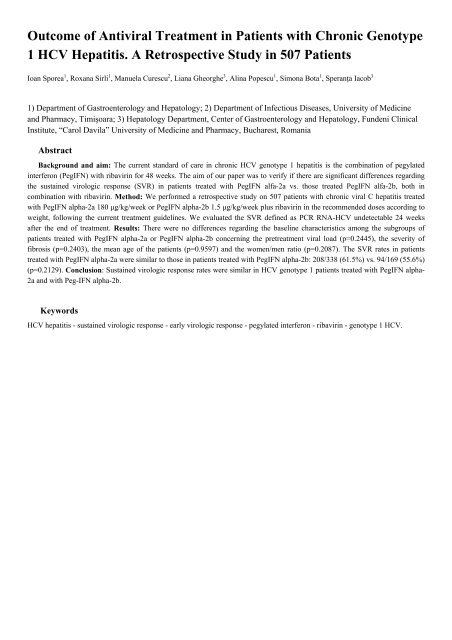Contents - Journal of Gastrointestinal and Liver Diseases
Contents - Journal of Gastrointestinal and Liver Diseases Contents - Journal of Gastrointestinal and Liver Diseases
Outcome of Antiviral Treatment in Patients with Chronic Genotype 1 HCV Hepatitis. A Retrospective Study in 507 Patients Ioan Sporea 1 , Roxana Sirli 1 , Manuela Curescu 2 , Liana Gheorghe 3 , Alina Popescu 1 , Simona Bota 1 , Speranţa Iacob 3 1) Department of Gastroenterology and Hepatology; 2) Department of Infectious Diseases, University of Medicine and Pharmacy, Timişoara; 3) Hepatology Department, Center of Gastroenterology and Hepatology, Fundeni Clinical Institute, “Carol Davila” University of Medicine and Pharmacy, Bucharest, Romania Abstract Background and aim: The current standard of care in chronic HCV genotype 1 hepatitis is the combination of pegylated interferon (PegIFN) with ribavirin for 48 weeks. The aim of our paper was to verify if there are significant differences regarding the sustained virologic response (SVR) in patients treated with PegIFN alfa-2a vs. those treated PegIFN alfa-2b, both in combination with ribavirin. Method: We performed a retrospective study on 507 patients with chronic viral C hepatitis treated with PegIFN alpha-2a 180 μg/kg/week or PegIFN alpha-2b 1.5 μg/kg/week plus ribavirin in the recommended doses according to weight, following the current treatment guidelines. We evaluated the SVR defined as PCR RNA-HCV undetectable 24 weeks after the end of treatment. Results: There were no differences regarding the baseline characteristics among the subgroups of patients treated with PegIFN alpha-2a or PegIFN alpha-2b concerning the pretreatment viral load (p=0.2445), the severity of fibrosis (p=0.2403), the mean age of the patients (p=0.9597) and the women/men ratio (p=0.2087). The SVR rates in patients treated with PegIFN alpha-2a were similar to those in patients treated with PegIFN alpha-2b: 208/338 (61.5%) vs. 94/169 (55.6%) (p=0.2129). Conclusion: Sustained virologic response rates were similar in HCV genotype 1 patients treated with PegIFN alpha- 2a and with Peg-IFN alpha-2b. Keywords HCV hepatitis - sustained virologic response - early virologic response - pegylated interferon - ribavirin - genotype 1 HCV.
Effects of Pro-Inflammatory Cytokines on the Production of Soluble Fractalkine and ADAM17 by HepG2 Cells Sharon L. Turner 1 , David Mangnall 2 , Nigel C. Bird 2 , Maria E. Blair-Zajdel 1 , Rowena A.D. Bunning 1 1) Biomedical Research Centre, Sheffield Hallam University, Sheffield; 2) Liver Research Group, Royal Hallamshire Hospital, University of Sheffield, Sheffield, UK Abstract Background & Aims: Soluble fractalkine is increased in the liver during times of injury; however the effect of proinflammatory cytokines in this process is currently unknown. The aim of this study was to determine whether pro-inflammatory cytokines elevated in patients with hepatocellular carcinoma influence fractalkine shedding from HepG2 cells and whether ADAM17 was involved in this process. Methods: In vitro experiments were performed in the human hepatocellular carcinoma cell line HepG2. Soluble fractalkine was detected using an ELISA. ADAM17 expression was investigated using quantitative real time (reverse transcription)-polymerase chain reaction and flow cytometry. Short interfering RNA transfection was used to downregulate ADAM17 expression. Results: Soluble fractalkine was present in supernatants of HepG2 cells, and was significantly increased by interleukin-1β (p≤0.005) and tumour necrosis factor-α (p≤0.043), but not by interleukin-6 (p≥0.316). This corresponded to minor increases in ADAM17 protein, but not ADAM17 mRNA, following the same treatments. However, the down-regulation of ADAM17 protein did not affect fractalkine shedding. Conclusions: This study showed that soluble fractalkine is up-regulated under inflammatory conditions associated with hepatocellular carcinoma development, but ADAM17 does not appear to be responsible for regulating this process. Keywords Fractalkine - ADAM17 - cytokines - cancer - hepatocellular carcinoma - HepG2.
- Page 1 and 2: VOLUME 19 NUMBER 3 SEPTEMBER 2010 E
- Page 3 and 4: Alkaline Reflux Esophagitis in Pati
- Page 5: Faecal Lactoferrin, Capsule Endosco
- Page 9 and 10: Prevalence of Gastroparesis in Type
- Page 11 and 12: REVIEWS Dosing 6-Thioguanine in Inf
- Page 13 and 14: Clostridium Difficile Infection and
- Page 15 and 16: Incomplete Deployment of an Expanda
- Page 17: Acute Spontaneous Chylous Peritonit
Outcome <strong>of</strong> Antiviral Treatment in Patients with Chronic Genotype<br />
1 HCV Hepatitis. A Retrospective Study in 507 Patients<br />
Ioan Sporea 1 , Roxana Sirli 1 , Manuela Curescu 2 , Liana Gheorghe 3 , Alina Popescu 1 , Simona Bota 1 , Speranţa Iacob 3<br />
1) Department <strong>of</strong> Gastroenterology <strong>and</strong> Hepatology; 2) Department <strong>of</strong> Infectious <strong>Diseases</strong>, University <strong>of</strong> Medicine<br />
<strong>and</strong> Pharmacy, Timişoara; 3) Hepatology Department, Center <strong>of</strong> Gastroenterology <strong>and</strong> Hepatology, Fundeni Clinical<br />
Institute, “Carol Davila” University <strong>of</strong> Medicine <strong>and</strong> Pharmacy, Bucharest, Romania<br />
Abstract<br />
Background <strong>and</strong> aim: The current st<strong>and</strong>ard <strong>of</strong> care in chronic HCV genotype 1 hepatitis is the combination <strong>of</strong> pegylated<br />
interferon (PegIFN) with ribavirin for 48 weeks. The aim <strong>of</strong> our paper was to verify if there are significant differences regarding<br />
the sustained virologic response (SVR) in patients treated with PegIFN alfa-2a vs. those treated PegIFN alfa-2b, both in<br />
combination with ribavirin. Method: We performed a retrospective study on 507 patients with chronic viral C hepatitis treated<br />
with PegIFN alpha-2a 180 μg/kg/week or PegIFN alpha-2b 1.5 μg/kg/week plus ribavirin in the recommended doses according to<br />
weight, following the current treatment guidelines. We evaluated the SVR defined as PCR RNA-HCV undetectable 24 weeks<br />
after the end <strong>of</strong> treatment. Results: There were no differences regarding the baseline characteristics among the subgroups <strong>of</strong><br />
patients treated with PegIFN alpha-2a or PegIFN alpha-2b concerning the pretreatment viral load (p=0.2445), the severity <strong>of</strong><br />
fibrosis (p=0.2403), the mean age <strong>of</strong> the patients (p=0.9597) <strong>and</strong> the women/men ratio (p=0.2087). The SVR rates in patients<br />
treated with PegIFN alpha-2a were similar to those in patients treated with PegIFN alpha-2b: 208/338 (61.5%) vs. 94/169 (55.6%)<br />
(p=0.2129). Conclusion: Sustained virologic response rates were similar in HCV genotype 1 patients treated with PegIFN alpha-<br />
2a <strong>and</strong> with Peg-IFN alpha-2b.<br />
Keywords<br />
HCV hepatitis - sustained virologic response - early virologic response - pegylated interferon - ribavirin - genotype 1 HCV.



